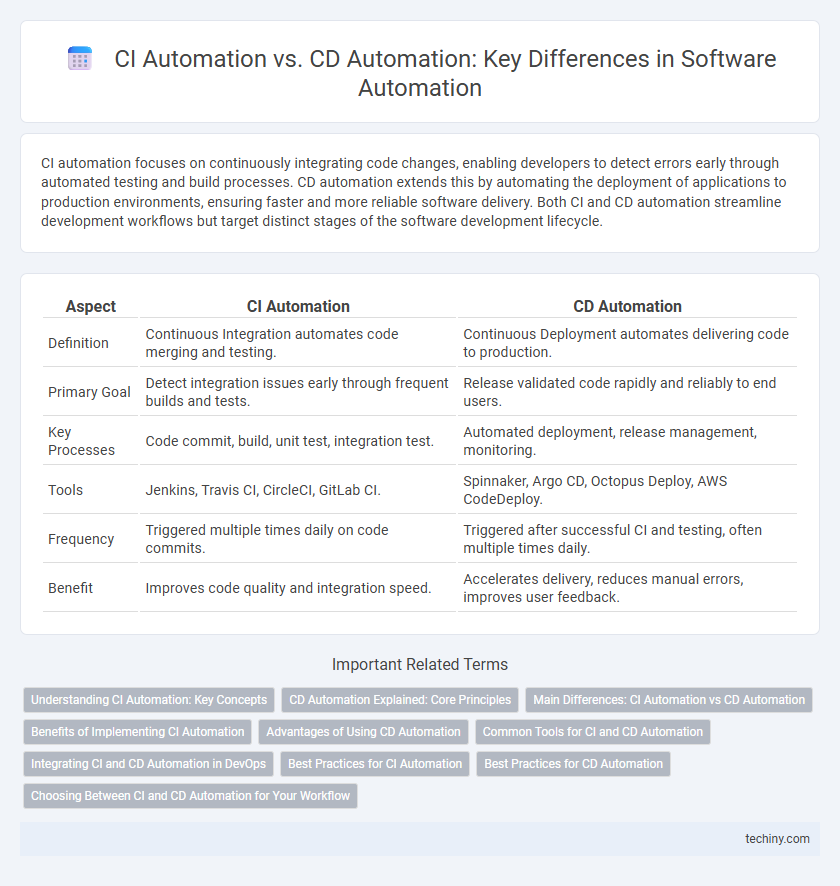CI automation focuses on continuously integrating code changes, enabling developers to detect errors early through automated testing and build processes. CD automation extends this by automating the deployment of applications to production environments, ensuring faster and more reliable software delivery. Both CI and CD automation streamline development workflows but target distinct stages of the software development lifecycle.
Table of Comparison
| Aspect | CI Automation | CD Automation |
|---|---|---|
| Definition | Continuous Integration automates code merging and testing. | Continuous Deployment automates delivering code to production. |
| Primary Goal | Detect integration issues early through frequent builds and tests. | Release validated code rapidly and reliably to end users. |
| Key Processes | Code commit, build, unit test, integration test. | Automated deployment, release management, monitoring. |
| Tools | Jenkins, Travis CI, CircleCI, GitLab CI. | Spinnaker, Argo CD, Octopus Deploy, AWS CodeDeploy. |
| Frequency | Triggered multiple times daily on code commits. | Triggered after successful CI and testing, often multiple times daily. |
| Benefit | Improves code quality and integration speed. | Accelerates delivery, reduces manual errors, improves user feedback. |
Understanding CI Automation: Key Concepts
CI automation centers on continuously integrating code changes into a shared repository, enabling early detection of bugs through automated builds and tests. Key concepts include version control, automated testing, and build automation, which collectively streamline development and maintain code quality. This approach reduces integration problems and accelerates feedback loops for developers, enhancing overall software reliability.
CD Automation Explained: Core Principles
CD Automation focuses on automating the deployment of applications to production environments, enabling continuous delivery and faster release cycles. Core principles include automated testing, infrastructure as code, and seamless integration with CI pipelines to ensure reliable and repeatable releases. This approach reduces manual intervention, enhances deployment consistency, and accelerates time-to-market.
Main Differences: CI Automation vs CD Automation
CI Automation focuses on automatically building and testing code to ensure early detection of defects, while CD Automation automates the deployment process, enabling faster and reliable release of software to production environments. CI emphasizes integration and validation of code changes frequently, whereas CD prioritizes continuous delivery or deployment to maintain a consistent release pipeline. Both are integral to DevOps pipelines but serve distinct roles in accelerating software development and operational efficiency.
Benefits of Implementing CI Automation
Implementing CI Automation accelerates development cycles by enabling frequent code integrations and automated testing, reducing integration errors and enhancing code quality. It ensures early detection of bugs, minimizing costly fixes in later stages and improving overall software reliability. Streamlined collaboration among development teams fosters continuous feedback, increasing productivity and faster time-to-market for software products.
Advantages of Using CD Automation
Continuous Deployment (CD) automation accelerates software delivery by automatically releasing validated code changes to production, reducing manual intervention and minimizing deployment errors. It enhances customer satisfaction through faster feature updates and bug fixes while ensuring consistent application performance and stability. By integrating continuous testing and monitoring, CD automation enables immediate feedback and rapid recovery from failures, boosting overall development efficiency and reliability.
Common Tools for CI and CD Automation
Common tools for CI (Continuous Integration) and CD (Continuous Deployment) automation include Jenkins, GitLab CI/CD, CircleCI, and Travis CI, which streamline code integration, testing, and delivery processes. These platforms support automated build, test, and deployment pipelines, enhancing software development efficiency and reliability. Containerization tools like Docker and orchestration solutions such as Kubernetes often complement CI/CD tools by managing deployment environments and scalability.
Integrating CI and CD Automation in DevOps
CI automation streamlines code integration by automatically building and testing code changes, ensuring early detection of defects and consistent software quality. CD automation extends this process by automating the deployment of validated code to various environments, enabling faster and reliable software releases. Integrating CI and CD automation in DevOps creates a seamless pipeline that accelerates delivery, enhances collaboration, and reduces manual errors throughout the software development lifecycle.
Best Practices for CI Automation
CI automation centers on integrating code changes frequently through automated testing and validation to catch errors early and maintain code quality. Best practices include maintaining a fast and reliable test suite, integrating code analysis tools, and ensuring clear communication with development teams. Automated builds triggered by commits promote continuous feedback and accelerate development cycles, enhancing overall project stability.
Best Practices for CD Automation
Continuous Deployment (CD) automation best practices emphasize frequent, reliable releases through automated testing, deployment pipelines, and monitoring to ensure rapid feedback and minimal downtime. Implementing robust rollback mechanisms and version control integration enhances system stability and fault tolerance during automated releases. Secure credentials management and comprehensive auditing within CD pipelines prevent unauthorized access and maintain compliance throughout the deployment process.
Choosing Between CI and CD Automation for Your Workflow
Choosing between CI automation and CD automation depends on the specific goals of your development process. CI automation emphasizes frequent code integration and automated testing to catch issues early and maintain code quality, while CD automation focuses on the seamless deployment of code changes to production or staging environments. Evaluating team priorities for rapid feedback, deployment frequency, and release stability will guide the optimal balance of CI and CD automation in your workflow.
CI Automation vs CD Automation Infographic

 techiny.com
techiny.com